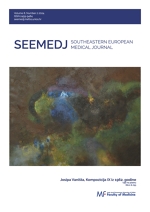Viral Infection in Glioblastoma: Immunohistochemistry in Detection of Cytomegalovirus, Epstein-Barr and Herpes Simplex – 1 Virus
DOI:
https://doi.org/10.26332/seemedj.v8i2.338Keywords:
cytomegalovirus;, Epstein-Barr virus;, Herpes simplex virus;, glioblastoma; , neurotropic viruses; , oncogenic virusesAbstract
Introduction: Glioblastoma (GB) is the most aggressive glial tumor of the brain with a dismal prognosis. Studies conducted during the last two decades highlighted neurotropic viruses as a risk factors involved in development of glioblastoma. Authors present an immunohistological study conducted in a single center on sixty-three archive paraffin-embedded samples of GB.
Patients and methods: The tissues were tested using immunohistochemistry in a homogenous group of sixty-three glioblastoma paraffin-embedded tissues for the presence of Cytomegalovirus (CMV), Epstein-Barr virus (EBV) and herpes simplex virus type 1 (HSV-1).
Results: Three species of herpes viruses were tested: HSV-1, Epstein-Barr virus (EBV) and Cytomegalovirus using the standard automatized immunohistochemistry. According to the IRS score, there were six samples of HSV-1 regarded as IRS 2 and five IRS 1 samples of the same virus. EBV and CMV were negative.
Conclusion: The result of our study identified HSV-1 as the most prominent neurotropic virus among population surgically treated of GB. Further studies are necessary to confirm its possible oncomodulatory role.
Downloads
Published
Issue
Section
License
Copyright (c) 2025 Southeastern European Medical Journal

This work is licensed under a Creative Commons Attribution-NonCommercial-NoDerivatives 4.0 International License.



